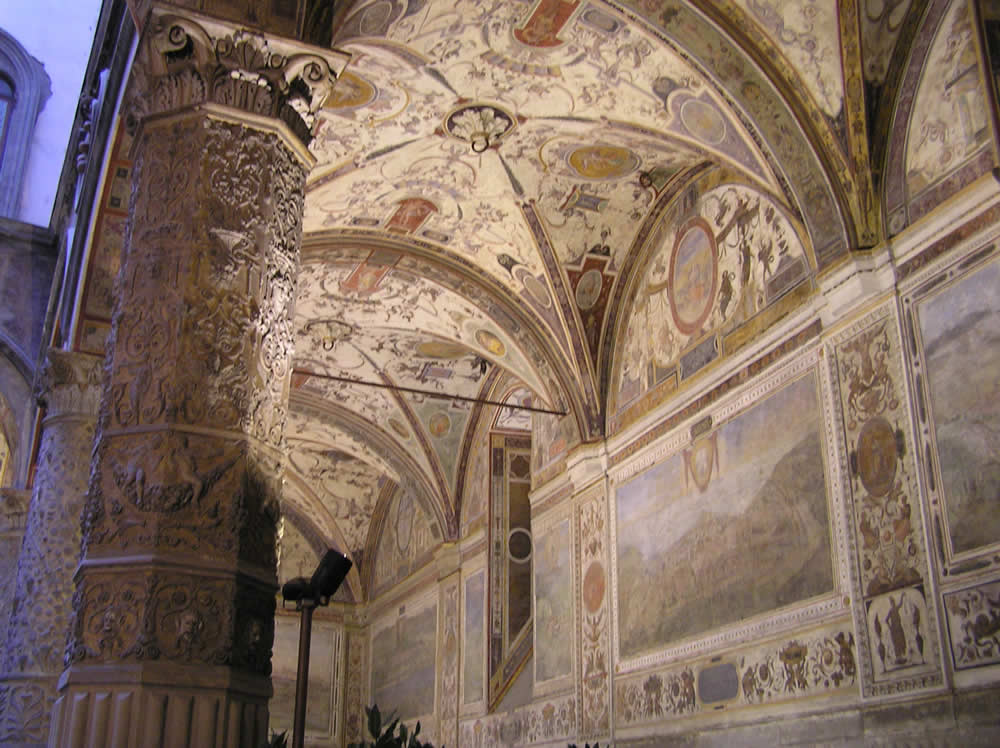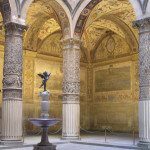Questo articolo è disponibile anche in:
![]() Français
Français ![]() Deutsch
Deutsch ![]() Español
Español ![]() Italiano
Italiano
The first courtyard of Palazzo Vecchio was built in the first half of the fourteenth century and then modified by Michelozzo in the fifteenth century. This architect replaced the pillars with cylindrical and octagonal columns and then built the loggia.
In the second half of the 16th century, the entire building underwent major modification works carried out by Vasari at the behest of Cosimo I de’ Medici. The courtyard of Palazzo Vecchio was decorated, on the occasion of the wedding between Francesco de’ Medici and Giovanna of Austria (1565), with stucco and dry paintings of Austrian cities, in honor of the bride.
At the center of the courtyard is the fountain by Francesco del Tadda (1555-57) with a reproduction of the putto and dolphin by Andrea del Verrocchio (Andrea di Michele by Francesco Cioni) from 1470. While the original is inside Palazzo Vecchio in the quarter of the Elements.
Cosimo I de’ Medici commissioned the artists Lorenzo Marignolli and Santi Buglioni to cover the gilded stucco columns with plant motifs, putti and other figurations. While the cross vaults were embellished by Marco da Faenza.

THE VIEWS OF AUSTRIAN CITIES
As said the walls of the courtyard were decorated, in 1565, at the behest of Cosimo I de’ Medici, on the occasion of the wedding between Francesco de’ Medici and Giovanna of Austria with views of the major cities of the Austrian empire. It shows: Prague, Passago (Passau), Stain, Closterneburg (Klosterneuburg). Vienna, Innsbruck, Ebersdorf, Costentz (Costanza), Neustadt and Hall (Ala).
The paintings, which were mostly dry executed, are the work of Bastiano Veronese, Giovanni Lombardi, Cesare Baglioni and Turino di Piemonte. While the coats of arms of the cities bearing the name in German were inscribed on the top of each panel, while the name in Italian was reported below.
The ovals placed in the lunettes above the city paintings represent important episodes of the government of Cosimo I. On the east wall of the courtyard there is an inscription in Latin, painted to welcome the future bride. In a niche there is the statue of Samson and the Philistine of Pierino da Vinci, Leonardo’s grandson who died at the age of 23.
Beyond the beautiful frescoed courtyard you enter the second courtyard, also known as “La Dogana”. This courtyard has massive pillars built in 1494 by Simone del Pollaiolo called Il Cronaca to support the “Salone dei Cinquecento” on the second floor. In this courtyard is the Marzocco weathercock, which was once on top of the Arnolfo tower.
Between the two courtyards are the two monumental stairways by Vasari with the access ramps to the upper floors of Palazzo Vecchio, which lead to the Salone dei Cinquecento and then to the Monumental Quarters.
We continue the visit in the Salone dei Cinquecento.
Questo articolo è disponibile anche in:
![]() Français
Français ![]() Deutsch
Deutsch ![]() Español
Español ![]() Italiano
Italiano








